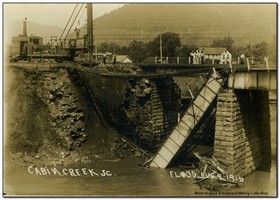 | Back to e-WV
| Back to e-WV
 The West Virginia Encyclopedia
The West Virginia Encyclopedia
 | Back to e-WV
| Back to e-WV
 The West Virginia Encyclopedia
The West Virginia Encyclopedia

West Virginia’s second-deadliest flood struck suddenly and without warning during the pre-dawn hours of Wednesday, August 9, 1916, when a storm front from the northwest dumped nearly six inches of rain in less than five hours on the headwaters of Cabin Creek in eastern Kanawha County. The Charleston Gazette newspaper reported the disastrous weather as “a cloudburst of immense volume” that struck “with the suddenness of a bolt of lightning.” Predictions had been for cooler weather and showers that day.
Coal communities, mines and railroad tracks lined the base of the steep, narrow valley surrounding normally placid Cabin Creek for most of its 20-mile length. The compact, low-lying communities were vulnerable to seasonal high water events, but the August flood was exceptional.
Heavy rain from the storm that struck Cabin Creek also produced damaging floods along nearby Paint Creek and the Little Coal River, but death and destruction were far more severe in the Cabin Creek watershed. Initial reports estimated that more than 100 people were killed, but as missing people were accounted for the death toll dropped.
After spending several weeks surveying damage and treating contaminated water wells to reduce the risk of infectious diseases like typhoid, State Health Department Chief Engineer Mayo Tolman revised the flood’s death toll to 71 and estimated the total number of homes destroyed at 900. The 1916 flood remained the state’s deadliest until the 1972 Buffalo Creek disaster in Logan County, which killed 125 people.
Since there were no official gauges to measure the rainfall that produced the flood, Tolman turned to the most accurate recording device he could find immediately after the storm: A ruler-equipped ice cream can used by an unofficial weather observer at Kayford. It tallied the storm’s total rainfall, most of which arrived between 4:30 and 9:00 a.m., at 5.82 inches.
Nearly 18 miles of railroad track along Cabin Creek was destroyed and not a single railroad bridge crossing the creek or its tributaries was left standing. During the flood, a spotter in a railroad tower above Dawes signaled the engineer moving a 50-car Chesapeake & Ohio freight train up the creek to stop. As the engineer did so, he saw the bridge in front of him collapse into the swollen stream.
Along the Little Coal River, a train carrying 210 picnickers from a Baptist Church group in St. Albans was marooned for two days when bridges behind and in front of the train collapsed. One of the church group’s younger members wrote a message detailing their plight, sealed it in a bottle and threw it into the river. Ten days later the note was recovered and read by a boy at Buffalo on the Kanawha River, nearly 60 miles to the north.
At Camp Kanawha in what is now Charleston’s Kanawha City neighborhood, more than 200 West Virginia National Guard troops who were preparing to ship out for Texas to help guard the U.S. border from raids by Mexican revolutionary Pancho Villa instead spent several days helping homeless and hungry flood victims. Troops moved their tents, cots, blankets and rations up Cabin Creek, then hiked along the slopes above the creek to reach homeless families and provide them with food and temporary shelter. In the days that followed, the troops used mule trains to haul emergency supplies to flood victims.
While many miners still resented the National Guard’s presence during the Paint Creek and Cabin Creek strike four years earlier, the two groups put shared history in perspective and worked together in the relief effort following the flood.
With mines inoperable and housing destroyed, nearly 60 percent of the miners who lived along Cabin Creek when the flood struck left the area to find work elsewhere.
Written by Rick Steelhammer
Tolman, Mayo. “The West Virginia Flood of August 9, 1916, and the Health Relief Measures”. The American Journal of Public Health, October 1916.
Charleston Gazette, August 10-14 1916.
USDA Weather Bureau Monthly Weather Review, Volume 44, August 1916.